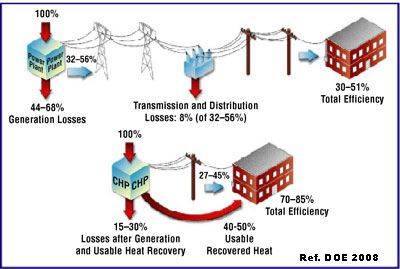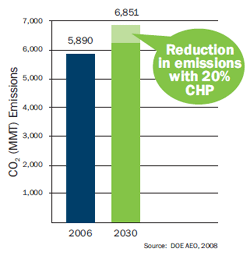CHP
Combined Heat and Power
What is Combined Heat and Power?
Nov 1st, 2012 Combined Heat and Power (CHP) is the concept where waste heat generated from any process should be considered as a source to generate electricity, which by its very nature places electricity generation closer to the point of consumption. Result: More efficient process with a low overall impact to the environment.

What do you mean by Combined Heat and Power?
Combined Heat and Power (CHP) is simply the idea of using a heat source directly or indirectly to generate both hot water and electricity. The reason that it makes sense to generate electricity on site is the fact that most legacy power plants lose more than 50% of the power generated from the point of generation to the point of consumption.
"The average efficiency of power generation in the United States has remained at 34 percent since the 1960s — the energy lost in wasted heat from power generation in the U.S. is greater than the total energy use of Japan. CHP captures this waste energy and uses it to provide heating and cooling to factories and businesses, saving them money and improving the environment. Recognizing the benefits of CHP and its current underutilization as an energy resource in the United States, the Obama Administration is supporting a new challenge to achieve 40 gigawatts (GW) of new, cost-effective CHP by 2020. Achieving this goal would:The above is according to a report published by the US Department of Energy, titled “Combined Heat and Power, A Clean Energy Solution”, Dated August 2012• Increase total CHP capacity in the U.S. by 50 percent in less than a decade
• Save energy users $10 billion a year compared to current energy use
• Save one quadrillion Btus (Quad) of energy — the equivalent of 1 percent of all energy use in the U.S.
• Reduce emissions by 150 million metric tons of CO2 annually — equivalent to the emissions from over 25 million cars
• Result in $40-$80 billion in new capital investment in manufacturing and other U.S. facilities over the next decade"

Technical Designs is Counting Carbon
Let's state the above one more time: Reduce emissions by 150 million metric tons of CO2 annually — equivalent to the emissions from over 25 million cars.
Think of it this way: For every one unit of energy produced by legacy grid providers, two units of carbon emissions are produced.
Recent hurricanes and natural disasters have shown the weakness in reliability of aging, large legacy grid systems and the need for a distributed grid architecture. This coupled with NetZero development trends predict a new distributed electric power grid architecture where power in many forms is generated close to the point of use and can achieve 75-80% overall efficiencies in comparison to the industry standard of 34% for legacy grid providers.
DOE, FERC and EPA as directed by Presidential Executive Order 13624 through the use of CHP have identified a way to reduce emissions, just by changing the way we deliver energy to the grid. CHP, which by its very nature places electricity generation closer to the point of consumption, is much more efficient with half the carbon produced and a lower overall impact to the environment.
Watch the this video to learn more...
Contact Technical Designs to discover your CHP Potential
As the Executive Order, states "There is no one size fits all solution.." Technical Designs has the expertise to take you from Concept and Evaluation right into construction and commissioning. We will help you navigate through regulations, rate structures, and rebates along the way and find the opportunities to make you a Carbon Considerate Entity.
Services
Presidential Order On CHP

"There is no one size fits all solution for our manufacturers, so it is imperative that we support these investments through a variety of approaches, including encouraging private sector investment by setting goals and highlighting the benefits of investment, improving coordination at the Federal level, partnering with and supporting States, and identifying investment models beneficial to the multiple stakeholders involved."Executive Order 13624, August 2012


